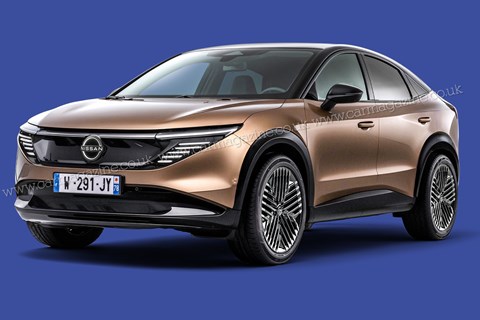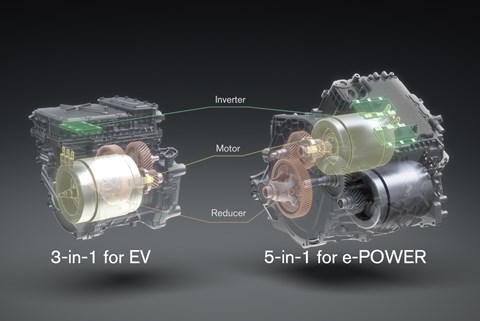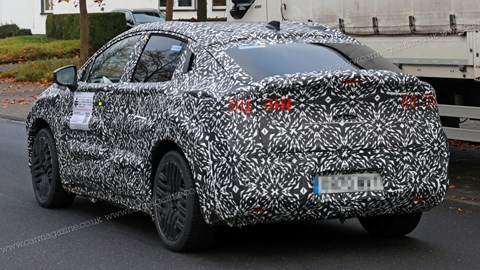► New-generation Leaf crossover confirmed
► One part of huge Nissan model offensive
► Will use Ampere platform, but Nissan-specific motors
Once a pioneer, the Nissan Leaf now goes mainstream for a new generation. Nissan has been developing the next iteration of its familiar electric car for a while now, with a launch planned for some time in 2025. Now our spy photographers have snapped it testing – and it’s very different to the car that came before.
These new pictures show something a more akin to crossover or SUV, which tallies up with what we already know about the next-gen Leaf. At Nissan’s Alliance 2030 conference in 2022, former Nissan boss Ashwani Gupta implied during Nissan’s that a future model would be spun out of the Chill Out concept car.
And as shown in these new pictures, the new Leaf’s design has evolved into a competitor of cars such as the Polestar 2 or Ford Capri.

The prototype car above is certainly crossover-shaped, and although covered, the front lights also correlate with a teaser we’ve already seen. The image below shows Nissan’s entire future line-up and the car at the front has similar lights to the Leaf prototype shown on this page.

What’s else is going on?
The new Leaf is just one part of Nissan’s enormous model offensive in the years to come. ‘We are bringing four EVs to the market [over the next few years],’ says Nissan senior vice president for sustainability and corporate affairs, Friederike Kienitz. ‘Three models [for Europe] – Juke, Leaf and Qashqai – are going to be EVs, and produced at the Sunderland plant.’ The fourth is the upcoming Micra – twinned with Renault’s 5 EV.
All of this is part of Nissan’s ‘Ark’ plan to introduce 30 new models – electric, electrified and combustion – by 2030 that should reinvigorate both the Nissan and upmarket Infiniti brands globally.
 CAR’s vision of the next-generation Nissan Leaf, illustrated by Andrei Avarvarii
CAR’s vision of the next-generation Nissan Leaf, illustrated by Andrei Avarvarii
As for what’s under the skin, it’ll be a real mix of Renault-Nissan-Alliance tech and Nissan’s own work. CAR understands that the new Leaf will run on what’s now called AmpR Medium – the architecture formerly known as CMF-EV that underpins the Nissan Ariya, as well as the Renault Scenic and Megane E-Tech Electric models.

However, a lot of the motor and battery technology will be Nissan’s own, stepping away from straight-up commonality with Renault’s electric cars. The brand has a manufacturing strategy for its electric motors, ensuring many of the same parts are used between battery-electric cars and Nissan’s E-Power range-extender models. ‘We call it three-in-one, and that’s what we’re putting into these new EVs going forward,’ says Moss. ‘We’re sharing the same core components – the reducer, the motor and the inverter – between E-Power and EV because there’s a lot of sense in doing that for engineering and economies of scale,’ says Moss. ‘But another benefit is that it enables us to start to make these units more compact.’ That means savings in weight, and less noise and vibrations for the production cars.
The next-gen Leaf will be available with Nissan’s vehicle-to-grid technology. Again, Nissan has shunned using Renault’s own V2G technology seen on the new R5 and developed its own tech instead. ‘The Alliance is not the same as it was in the past,’ says Moss. ‘We have an information exchange, but it’s different now. Sometimes you ask to make things by contract, but in this case it’s Nissan technology.’

Nissan has also confirmed that the Leaf, as well as the next-generation Qashqai and Juke EVs will be built at its Sunderland plant in the UK. Nissan is shaping Sunderland into an enormous battery-electric car hub, including its own battery manufacturing plant. ‘The original Leaf plant is 1.8 gigawatts, but this will be a nine-gigawatt plant,’ says Moss. The project is scalable, too, so there’s room for expansion.
We’ve been waiting a while already, given the current Leaf has gone from a barely-competitive EV when it was new to an also-ran in the fast-changing world of EVs. But Nissan is expected to launch the new-generation Leaf in 2025.